spkit.data.moons¶
- spkit.data.moons(N=[100, 100], s=0.1, d='random', angle='random', return_para=False, **kwargs)¶
Generate a 2-class dataset from two “moon” distributions
Sample a dataset from two “moon” distributions
- Parameters:
- N: list or two int, default =[100,100]
vector that fix the number of samples from each class
example N = [100,100], 100 samples for each class
- s: scalar, default=0.1
standard deviation of the gaussian noise.
- d: scalar, str, default=’random’
1x2 translation vector between the two classes.
With d = 0 the classes are placed on a circle.
- angle: scalar , default=’random’
rotation angle of the moons (radians)
New in version 0.0.9.7: Added to return parameters
- return_para: bool, default=False
if True, return the parameters
- Returns:
- X: 2d-array
data matrix with a sample for each row
shape (n, 2)
Changed in version 0.0.9.7: shape is changed to (n, 2)
- y: 1d-array
vector with the labels
Changed in version 0.0.9.7: shape is changed to (n, )
- (s, d, angle): parameters
if return_para=True
See also
Examples
#sp.data.moons import numpy as np import matplotlib.pyplot as plt import spkit as sp np.random.seed(7) X, y = sp.data.moons(N =[100, 100],s=0.2,d='random', angle='random') np.random.seed(None) plt.figure() plt.plot(X[y==0,0],X[y==0,1],'o') plt.plot(X[y==1,0],X[y==1,1],'o') plt.xlabel('x1') plt.ylabel('x2') plt.title('Moons Data') plt.show()






